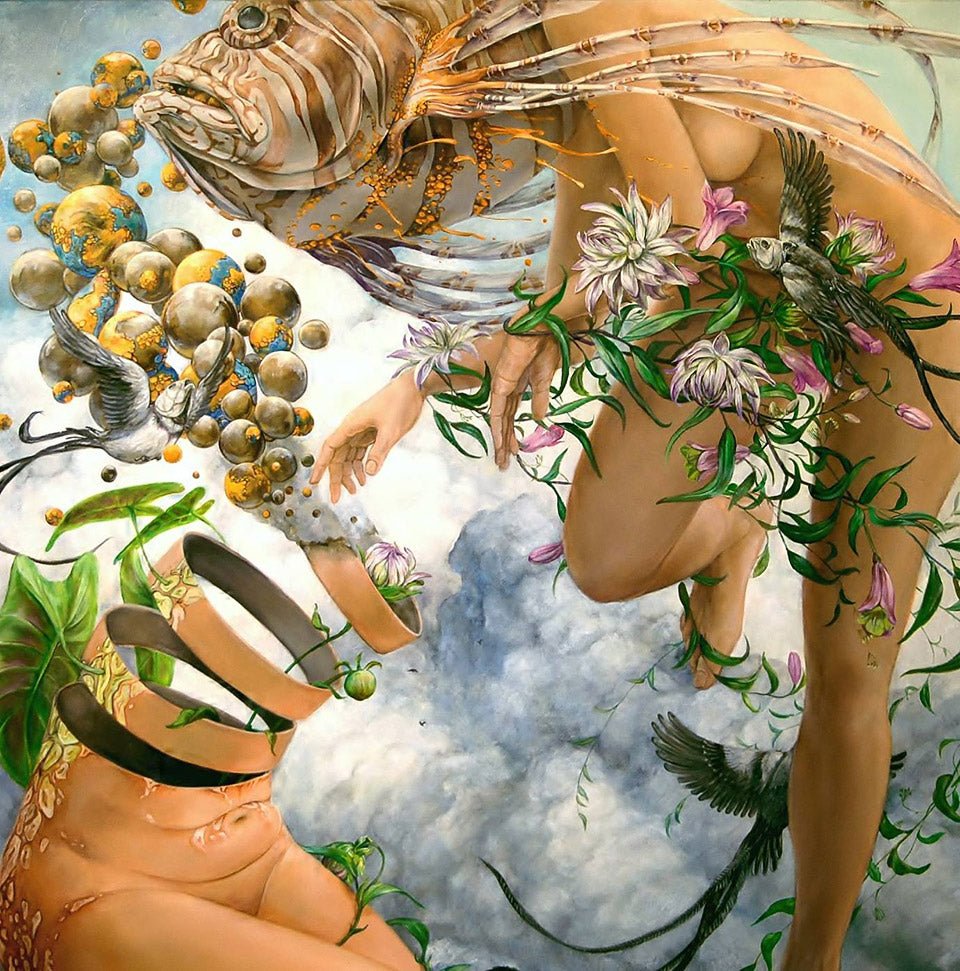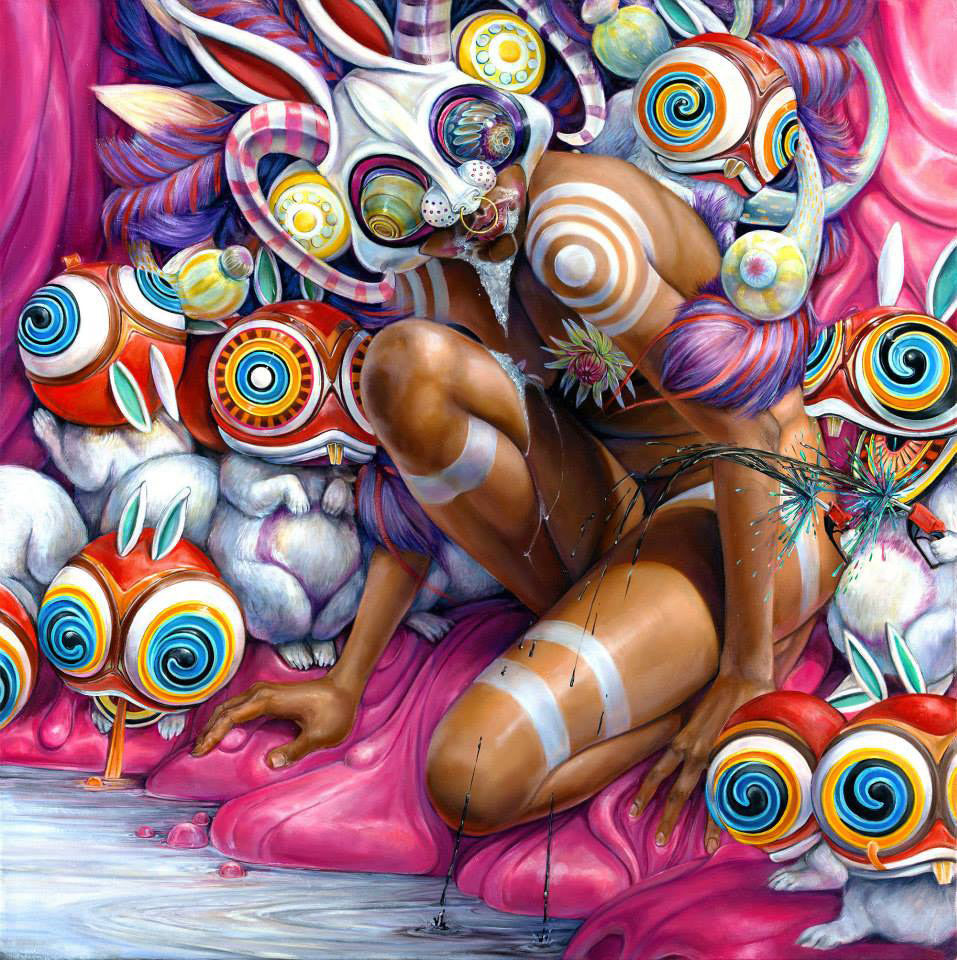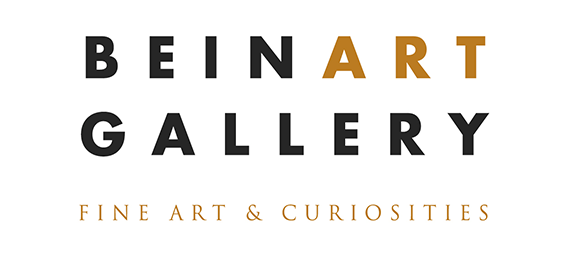
Hannah Yata painting in her studio.
Hannah Yata weaves nature, feminine imagery, and other elements into pieces that can both soothe and challenge: while her paintings are beautiful, often with a candy colour palette, they also confront us with complex perspectives on humans and their world. Sometimes wry and sometimes shocking, Yata’s work is invariably arresting.
“I think an image that arrests us, takes hold of our mind long after we have left its presence, and causes us to look at something deep within ourselves trying to search for the meaning—I think that is magic, and that’s the kind of magic that can make a difference in the world.” —Hannah Yata
See available paintings by Hannah Yata.

Eden - Oil on canvas by Hannah Yata.
Julie Antolick Winters: What started you on the path to creating art?
Hannah Yata: I think it started as a search. I had always dabbled with art making as a child and adolescent, making comics, drawing little animals and looking at the paintings in bible study books. As I grew up, I met a lot of obstacles, and making art was the biggest thing I turned to for solace. When I began to study art in college and work with oils, that’s when a passion turned into an obsession.
JAW: Your bio on your website notes that you studied psychology and feminism alongside art in college. It’s clear that psychology and women feature heavily in your work, and I imagine that your studies in college were at least a beginning in weaving these things together. But was there a time that you considered a non-artistic path pursuing either of those subject areas?
HY: Yes, for a while I gravitated more to the rational idea of being coming a doctor of some kind—particularly psychology. However, my propensity for memorising facts and regurgitating a lot of information wasn’t something I was inclined to with a subject that tended to discuss a lot of dry material. I realised quickly I just wanted to create visually and psychologically liberating work and that I could do my studying, reading and writing on the side.

Left: Honey, Right: Gentle - Oil on canvas by Hannah Yata.
JAW: Tell us about how your work evolved to explore the natural world as well as the status of women.
HY: I had felt it in my early years becoming a woman. I saw myself through other people’s eyes, judging other women by those “other” eyes, too. Glamour magazines showed us how we should look: tempting, wanting, hot, sexual, untouchable, and mostly all of the above: the Madonna/whore. It entrenched itself into my psyche, and I began to hate my body, hate my clothes and hate everything that couldn’t give me the security that I needed as a young girl.
Then I took a class, an art history class, that discussed the course of history and how women’s bodies had been portrayed and the psychology behind it. I was hooked. I kept looking; I needed to hear the truth. Then I found Eve Ensler. I think her compassion for other women caught me off guard in a way that I had never encountered. I pored through her books and tried to find her talks on the Internet. When I found her stories about her fight with cancer and how the years of traveling, testimonies from other women, her battle with her self-image destroyed her body, it broke the idea that had been knocking at the door of my consciousness for a while: the body of the woman was an extension of the earth.
Control meant to keep [a woman] preoccupied with her body, to use the people that surrounded her to shame her if she went out of line. It wasn’t just men; it was other women, too. Women were shamed by men and women alike for not conforming to ideas of beauty or tradition. The woman was cut and manicured, she was altered and packaged for consumption. Likewise, the landscapes bulldozed, mountains flattened, and forests leveled to for us to find the materials we needed for our machine. Nature was to serve humans, as women were to please others.

Daughters - Oil on canvas by Hannah Yata.
JAW: Do you feel that these simultaneous themes point to an overarching theme?
HY: I’m under the impression that humans keep looking for spirituality for a reason. They find themselves vulnerable to religion, ideology, gurus and shamans to lead them to enlightenment or a closer relationship with a god. Maybe this is the conspiracy of it all, that instead of looking up for god, “god” was beneath our feet and all around us. She was hiding; they were hiding—in the forests, trees, rocks, water and air. It’s birth and death, magic and mystery, connection and disconnection. I get the sense that it starts to point to our existence as crazy blundering children in the midst of an ancient world.

Cacophony - Oil on canvas by Hannah Yata.
JAW: How has your thinking about the topics depicted in your paintings changed, if at all, as you’ve examined them through your art?
HY: I think they’ve changed in certain ways. Maybe subtle ways, and maybe it’s just my attitude. I think before I was more focused on the woman and her appearance and place and society as it related to man. Now, I feel like I’m slowly finding the language of nature, the feminine, and peering into the concept of what it means to be wild and the energy that exemplifies that force.

Fire Child - Oil on canvas by Hannah Yata.
JAW: The use of masks in your paintings is compelling; the masks seem to both de-personify the women and humanise the animals. Would you say that there is an element of humanity hiding from itself in your work?
HY: The mask is a simple idea, probably used since humans came together thousands of years ago. I think its root run deep: it speaks to our subconsciousness; it allows us to become something else for a little while. It lets us step into the shoes of another being, whether that be deity or demon—maybe even what some would call the shadow self. The freedom that’s felt behind the mask is a wild, primal one. It touches at the heart at what we feel is behind and around us—that something of an “otherness,” perhaps the invariable flicker of madness that is alive within us all.

Sublime Madness - Oil on canvas by Hannah Yata.
JAW: In an interview with buzzworthy, you said that your greatest dream is to make a difference and to make a masterpiece. Do you see art as a vehicle for making a difference through the ideas you’re trying to communicate?
HY: I do. I think art has its power, and that’s in the image. When we think, we think in pictures and stories, not so much in words or symbols. I think an image that arrests us, takes hold of our mind long after we have left its presence, and causes us to look at something deep within ourselves trying to search for the meaning—I think that is magic, and that’s the kind of magic that can make a difference in the world.

Bloom - Oil on canvas by Hannah Yata.
JAW: I know you like to leave the interpretations of the pieces up to the viewers, but do you feel you know the whole story of a painting before you begin it, or does it reveal itself to you during its creation?
HY: That’s a great question, and sometimes it varies. I used to come up with a whole story before I did my pieces but quickly realised I was suffocating my creative freedom by doing so. The more I painted, the more I trusted my intuition and the flickers of images that would reoccur in my mind. It frequently happens that I see something and feel like I’m chasing a ghost of fragments and symbolism trying to figure out what an image was telling me. As I look back on the paintings I’ve created in the past 5 to 6 years, I can see something that was fighting to emerge. Before I could say it was a lot of personal stuff, but now I’m under the impression I feel more like an observer to something bigger.

Aether - Oil on canvas by Hannah Yata.
JAW: Some elements, such as butterflies, recur in several pieces. How do you decide what elements to incorporate into a piece?
HY: It’s pretty hard to figure out what a piece needs, but I guess that’s why they tend to take so long. So if you consider pieces like Daughters, The Moors and The Donner Party, for example, they all have butterflies in them. Daughters is heavier and darker in subject matter, talking about the mutilation and death of women and elephants. The Chalkhill Blue butterflies were chosen because of their mystical wispy appearance along with the idea that the figures are going through some sort of transition. With The Moors, a bit of an older piece, the monarchs were not only there as an aesthetic choice but could also be talked about in terms of genetic memory and the willpower of something so fragile. In The Donner Party, butterflies are incorporated to point to food sources around while the flock of birds has decided to attack each other.

The Insanity Defense - Oil on canvas by Hannah Yata.
JAW: I was excited to learn that you’d had an internship with Martin Wittfooth—he’s one of my favourite painters—and Adam Miller. How did that come about, and what was the most valuable thing you carried from your time with them?
HY: Yes, they are both amazing artists!
I found Martin online when I was in college in 2011. I had begged my teachers to tell me how he was able to paint like he did, and they said, “Go ask him for an internship.” So I asked, he accepted, and [he] introduced me to Adam Miller since Adam also needed some help around the studio.
The most valuable lesson they taught me was vision and persistence. It wasn’t explicitly said, but I could see it every day I went to help Martin or Adam. They were smart, passionate and loved what they did, and you could feel it.

Polymorphous - Oil on canvas by Hannah Yata.
JAW: You have spoken in interviews about the dangers of trying to please others when making art. How do you balance the need to market and sell with the need to listen to your own voice?
HY: I think when I used to have another job to support me, that helped me find my voice and lose my fear of whether or not I would make money. I was surprised when my fish-headed women got so much attention, but I didn’t want to stop there. I knew there was more beneath it, so I keep digging and keep trying to find the meat of the matter. When I quit my full-time job, I balanced the work that I feel compelled to do with commissions. I don’t tend to take many commissions, but they are usually what I would call “safe:” something based on what I’ve done already and isn’t super challenging. When I approach of a body of work I make for myself, the last thing I worry about is “is it going to sell?” So between the two, I try to keep them separate but balanced.

Left: Diaphonia, Right: Harvest - Oil on canvas by Hannah Yata.
JAW: Do you have any thoughts about the use of social media as a tool for both promoting and accessing art—the positives as well as any pitfalls?
HY: I see the pattern of many artists that get attention for one thing and then they become terrified of expounding on that vision for fear of losing their audience. I believe the Internet is a powerful thing: for the first time in history we almost have no excuse not to put our stuff out there and try to be our own boss. I think the goal is not to get too wrapped up in the numbers and the attention that it becomes an addiction that distracts you from making your best work.
JAW: What might a viewer be surprised to learn about you as an artist?
HY: They might be surprised how much I actually work!

Do Not Resuscitate - Oil on canvas by Hannah Yata.
JAW: Is there anything you’d like to tell our readers about what’s coming up on the horizon for you, e.g., any new shows or themes you’re working on?
HY: I’m working a two-person show [at Parlor Gallery, Asbury Park, NJ] with my husband [Jean Pierre Arboleda] this fall about the origins of Christianity/religion and the mushroom. Jean Pierre’s work tends to be sweeter and mine a little more disconcerting, but I can see we are feeding off each other’s energy, so from the paintings we’ve already put together, I know it’s going to be a lot of fun!
Solo show-wise, I’m grappling some larger paintings/themes that I’m trying to work out. Hopefully, I’ll be able to unveil some of them by April of next year.

The Confidante - Oil on Canvas by Hannah Yata.
This interview was written by Julie Antolick Winters for Beinart Gallery in 2017.
Julie Antolick Winters is a writer and editor residing in the state of Maryland, USA, in a small city near Washington, D.C. Julie cowrote the introduction for Black Magick: the Art of Chet Zar and co-copyedited this book and Kris Kuksi: Divination and Delusion for Beinart Publishing. She has also been conducting artist interviews for the Beinart Collective & Gallery since 2010. In addition to her work for the Beinart Gallery, she edits science articles and books, writes poetry and practices the art of negotiation with her son.




 Cart
Cart



